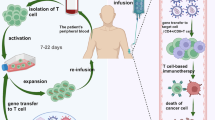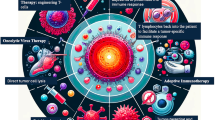Summary
Courses of tumors, which had been induced in adult STU mice with a regressor and with a progressor strain of Moloney sarcoma virus (MSV-M) were followed and compared. All 73 tumors induced by the regressor strain of MSV-M (R-MSV-M) regressed and 181 of 183 tumors induced by a progressor strain (P-MSV-M) grew progressively and killed their hosts between 16 and 171 days after infection. Even after inoculation of about 4 FFU of P-MSV-M tumor development may occur and lead to progressively growing tumors.
Both strains of MSV-M induce strong immune responses in their host, namely cytotoxic effector cells, cytotoxic antibodies and tumor resistance. Simultaneous injection of mice on separate sites with P-MSV-M on one side and R-MSV-M producing ascitic cells on the other side did not induce mutual influences on the different tumor courses. It is therefore concluded that the immune response is obviously not decisive for the failure of P-MSV-M induced tumors to regress.
From seven P-MSV-M induced primary tumors two producer and five nonproducer transformants could be isolated, maintained in culture and partly held as easily transplantable tumors in adult immunocompetent mice. Both producer transformants release sarcoma virus with the capacity to induce progressively growing tumors in adult mice. All transformants induce progressively growing tumors after transplantation independent of the applied cell dose.
It is concluded that the ability of the P-MSV-M to induce stably transformed cells (in contrast to R-MSV-M,Weiland et al., Brit. J. Cancer, 1979) favours clonal development and ultimately progressive tumor course, in spite of the presence of an immune response.
Similar content being viewed by others
References
Aoki, T., Stephenson, J. R., Aaronson, S. A.: Demonstration of a cell-surface antigen associated with murine sarcoma virus by electron-microscopy. Proc. Natl. Acad. Sci. U.S.A.70, 742–746 (1973).
Bean, M. A., Pees, H., Fogh, J. E., Grabstald, H., Oettgen, H. F.: Cytotoxicity of lymphocytes from patients with cancer of the urinary bladder: detection by a3H-proline-microcytotoxicity test. Int. J. Cancer14, 186–197 (1974).
Herberman, R. B., Ting, C. C., Kirchner, H., Holden, H. T., Glaser, M., Bonnard, G. D., Lavrin, D. H.: Tumor immunity. In:Brent, L., Holborow, J. (eds.), Progress in Immunol., II,31, 285–295 (1974).
Lavrin, D. H., Herberman, R. B., Nunn, M. E., Soares, N.:In vitro cytotoxicity studies of murine sarcoma virus-induced immunity in mice. J. nat. Cancer Inst.51, 1497–1508 (1973).
Levy, J. P., Leclerc, J. C.: The murine sarcoma virus induced tumor: Exception or general model in tumor immunology? Adv. Cancer Res.24, 1–66 (1977).
Rapp, U. R., Todaro, G. J.: Generation of new mouse sarcoma viruses in cell culture. Science201, 821–824 (1978).
Rowe, W. P., Pugh, W. E., Hartley, J. W.: Plaque assay techniques for murine leukemia viruses. Virology42, 1136–1139 (1970).
Simons, P. J., McCully, D. J.: Pathologic and virologic studies of tumors induced in mice by two strains of murine sarcoma virus. J. nat. Cancer Inst.44, 1289–1303 (1970).
Stephenson, J. R., Aaronson, S. A.: Antigenic properties of murine sarcoma virus-transformed Balb/3T3 nonproducer cells. J. exp. Med.135, 503–515 (1972).
Takeichi, N., Boone, C. W., Holden, H. T., Herberman, R. B.: Immunological study of two stocks of Moloney sarcoma virus producing regressor and progressor tumors in C57BL/6 mice. Int. J. Cancer21, 78–94 (1978).
Ting, R. C., Bader, A. V.: A quantitative study of transformation of hamster embryo cellsin vitro by murine sarcoma viruses (Harvey and Moloney). Virology39, 194–204 (1969).
Weil, R.: Viral tumor antigens. A novel type of mammalian regulator protein. Biochem. biophys. Acta516, 301–388 (1978).
Weiland, E., Mussgay, M.: Tumor inhibiting capacity of spleen and lymph node cells from mice with murine sarcoma virus (MSV-M-)induced tumors. Z. Immunitätsforsch.150, 414–423 (1975).
Weiland, E., Mussgay, M.: Detection of cytotoxic lymphoid spleen cells from STU-mice with Moloney sarcoma by a3H-proline microcytotoxicity assay. Med. Microbiol. Immunol.162, 81–87 (1976).
Weiland, E., Mussgay, M., Weiland, F.: Nonproducer malignant tumor cells with rescuable sarcoma virus genome isolated from a recurrent Moloney sarcoma. J. exp. Med.148, 408–423 (1978).
Weiland, E., Weiland, F.: Transplantierbarer Aszitestumor aus einer Maus mit einem Moloneysarkom: Tumor-, Antigen- und Viruseigenschaften. Z. Immunitätsforsch.148, 151–161 (1974).
Weiland, F., Weiland, E., Mussgay, M.: Growth pattern of tumours in mice induced by murine sarcoma virus-Moloney and by sarcoma virus transformed cells. Brit. J. Cancer40, 932–942 (1979).
Author information
Authors and Affiliations
Additional information
With 1 Figure
Rights and permissions
About this article
Cite this article
Weiland, E., Mussgay, M. Tumors induced by progressor sarcoma virus (Moloney) in mice: Growth in the presence of an immune response and isolation of autonomously growing cells. Archives of Virology 66, 1–10 (1980). https://doi.org/10.1007/BF01315040
Received:
Accepted:
Issue Date:
DOI: https://doi.org/10.1007/BF01315040




